Special systems
Special systems
In most cases, special systems are in use on special ships. Its impossible to list all special systems and this chapter therefore highlights some to give an impression.
1. Types of special systems
General cargo vessels like bulk carriers and multi-purpose cargo vessels do not require special systems. They have a number of straightforward systems which have been discussed in previous chapters.
Some examples of vessels with special systems are:
Container ships which have a heeling system to keep the vessel upright when loading and unloading containers. These ships also have sometimes sophisticated supply and monitoring systems for the cooled containers.
Very Large Crude Carriers (VL- CCs) which have large cargo oil pumps on high voltage for cargo discharge.
Luxury yachts that have sophisticated computer controlled lighting and entertainment systems and high-tech AC systems.
Passenger/car ferries have three distinguished areas with each special systems: passenger areas, car decks and engine spaces.
Dredgers which have large hydraulic control systems for valves and cargo doors, sophisticated electronic systems to control and monitor the dredging process and sometimes very large high voltage dredging pumps.
Chemical tankers which have hydraulic control systems for the cargo valves on deck, tank level monitoring and an emergency propulsion system which is discussed later in this chapter.
Drill ships which have specialized drilling related systems and sophisticated electronic systems to support the drilling process such as a DP system. A Remote Operated Vehicle (ROV) system is also part of the equipment.
Cable laying vessels, Pipe laying vessels and Diving support vessels with DP systems have been discussed in an earlier chapter.
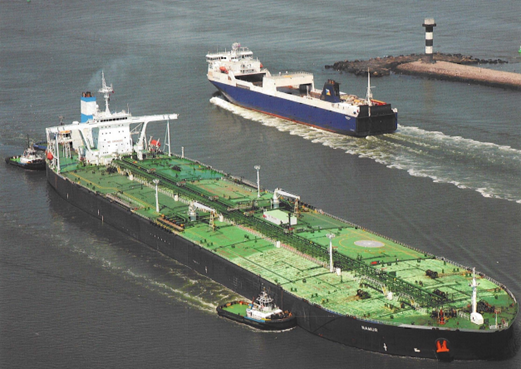
Very Large Crude Oil Carrier (VLCC) and Car Ferry
2. Examples of special systems
2.1. Examples of special systems
Helicopter facilities are provided on many ships. Large oil tankers, bulk carriers and container ships have helicopter landing areas on deck to get a pilot on or off the ship. Special, pre-fabricated large helicopter platforms usually installed on large offshore equipment, such as drilling rigs, diving support ships, pipelaying barges, crane vessels, etc. These are normally made of aluminium. These platforms are then used for crew changes and or delivery of supplies when the vessel is remote from shore. When the distance is large from the shore base a helicopter must be refuelled on the vessel and the helideck then will have a heli refuelling system.
Large yachts increasingly have helicopter facilities and sometimes indoor stowage facilities for a small, two- or four-seat, helicopter.
For larger certified helicopter decks there are a number of requirements to be fulfilled which are detailed in the Offshore Helicopter Landing Areas - Guidance on Standards CAP 437 which is issued by the UK Civil Aviation Authority.
Larger certified helicopter decks have special lighting arrangements for night operations with perimeter lighting, flood lights and windsock lighting. When there are large objects in the approach path of the helicopter these have to be provided with red obstruction lights.
In addition to the above, drilling vessels must have one or more Heli Status Lights which are connected to the Emergency Shutdown System (ESD) and are activated when there is a degradation of the safety level on the vessel. An approaching helicopter will be warned not to land. When already landed to take off immediately.
When helicopter refuelling is required the fuel pumps must be provided with an emergency stop from a safe location and the associated control equipment must be an explosion-proof type.
Furthermore an approved semiconducting delivery hose on a storage reel must be fitted and a suitable (high visibility) bonding cable must be used to earth the helicopter frame to the ship's construction before any refuelling (or de-fuel- ling) commences.
Helicopter systems also include communication systems and approach beacons.

Heli windsock
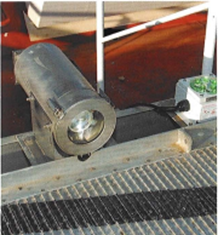

Heli deck flood and perimeter light
2.2. Shaft Generators
Electric power on board ships is normally created by independent diesel generators. However, necessary power can also be produced by the main engine through an attached generator, which is either always rotating when the main engine is running or attached via a coupling. With a coupling the generator can be connected when required.
When the shaft generators have the same rating as the diesel generators these can be switched off at sea. This electricity produced by the main engine is cheaper due to the use of cheaper fuel.
Various configurations and options are available. One main engine or two. One shaft generator or more. Direct-driven or via a reduction gearbox. When the main engine is a long stroke slow-running engine, a very big multi-pole shaft generator running at shaft speed or a step-up gear is necessary to drive the generator.
Between the diesel and the shaft generator other kinds of drives can be used: V-belts or even chains or a clever type of transmission which changes variable speed into constant speed within certain limits.
2.3. Exhaust-gas powered generators
Large container ships produce a lot of heat with the huge, high powered main engine. This heat, in the form of exhaust gas, is utilized for other purposes as far as practicable, by making steam in an exhaust-gas boiler. The steam, when superheated, is sufficient to drive a steam generator.
This steam turbine driven generator produces more than sufficient electric power for the ship's normal use. This surplus power can be used in an auxiliary electric propulsion motor and provides power for the propeller shaft. In this case, a shaft generator is not needed as the heat from the main engine can be used to produce the necessary electric current.
Auxiliary diesel generators are installed to produce power when the ship is in port.
2.4. Emergency propulsion
Emergency propulsion is a system which is used on for instance chemical tankers where an accident with the vessel and spill of its cargo could have grave consequences.
The basis of emergency propulsion systems is a shaft generator or PTO (power take off) generator, converted by switchgear into an electric motor, supplied by auxiliary generators. As a generator is not identical to a motor it can only produce torque as a motor after it has been synchronised and switched to the main power plant. Some systems use a small electric motor, a pony motor, to drive the generator up to synchronous speed and then synchronising and closing the circuit breaker. Another solution is to change the generater into a motor during this running up period. This is done by short-circuiting the rotor windings with a device fitted on the rotor. As soon as the rotor runs synchronously, the short-circuit is interrupted and the rotor is excited by the AVR.
For inland tankers on the River Rhine it is obligatory to have emergency propulsion capable of reaching 10 km/hr. In some cases this is provided by the omnidirectional bow thruster, using the thrust in aft direction or through a shaft generator, configured as an electric motor.
2.5. Remote Operated Vehicle
Remote Operated Vehicles (ROV) are small robots with cameras, lights and arms that can be used to survey the seabed and work on connections.
Special consideration should be given to the quality of the power supplies to a ROV. Any disturbances, from for example harmonic distortions in the ship's electrical system, are amplified due to the capacity and the length of the umbilical cable. In some cases it is therefore advised to use a rotating motor-generator converter to produce clean power to the ROV system.
An ROV is launched from the vessel and then controlled from a ROV control desk. The electrical supplies and controls are transferred via an umbilical cable. As an ROV can operate at great depth the power supply for the propellers on the unit are fed with 3000V from a dedicated switchboard.

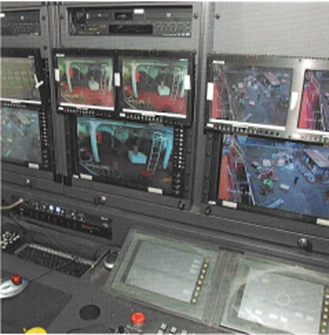
ROV descent equipment ROV control panel
2.6. Drilling Equipment
Drilling vessels have many highly specialized systems on board. Although the type of drilling determines the typical configuration there are a number of standard systems like the drill equipment and iron roughneck, the system to hold the drill pipe, that can be found on all drilling vessels. A low and high pressure mud system, to bring mud for drilling to the bore hole, will also be installed.
When the operations involve drilling for oil or gas there will be extensive hazardous areas with safety systems, such as fire and gas detection and an emergency shutdown system.
To alert the crew when the DP system is degraded or when the DP cannot hold position due to changed environmental conditions a DP alert system will be fitted. This system comprises signal colums as a sort of traffic lights and an alarm horn which will sound on a change of status
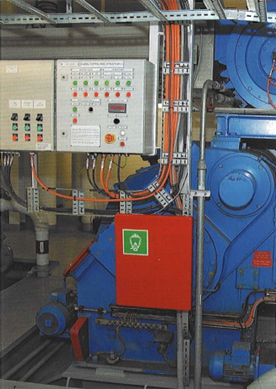
HP Mud pump with auxiliary controls
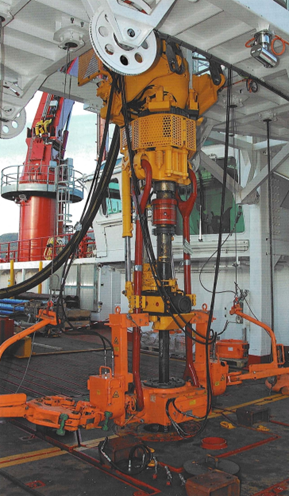
Drilling floor with top drive system
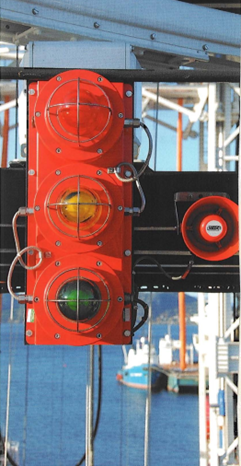
Signal "traffic light" DP with siren
2.7. Pipe laying barges
Pipe laying at sea is a complicated procedure, especially when dealing with large pipe diameters in the order of one metre. Pipe laying vessels most of the time are converted ships or barges on DP, where the thrust of the propulsers is not only used to hold the vessel on location but also to deliver the pulling force for the pipe, hanging down from the barge.
The pipe is held strongly by the tensioners, large hydraulic clamps, preventing the pipe dropping from the vessel. The water depth can be as much as 2500 metres. The electrical demand is huge.
The main consumers are the thrusters, tensioners, welding, lots of hydraulic systems, many cranes, and an accommodation for up to 400 persons. And all those systems are in use at the same time, 24 hours a day.
Six or eight large capacity diesel generators, each in the 3-4 MW range to produce electrical power, is normal for this type of vessel. Redundancy requirements are maximal, which means complete double engine rooms, and thruster capacity (DP3 class).
The Dynamic Positioning is complicated. Weather vaning, (heading resulting from wind and current) which is acceptable for a drillship, as the drillstring is the decisive location, is not good enough for laying pipes. The pipe has to be layed along an accurately planned track, and the ship or barge has to be kept above that line, in the proper direction. Current and wind/waves can be from abeam.
When a weld in the pipe is completed, the ship has to move forward the length of the 'joint', 12, 24 or 36 metres. The necessary allowance in fore and aft position, controlled by the tensioners and limited by the size of the welding stations, is about one metre.
Moving from one job to another is done under own power, using the thrusters assisted by tugboat(s), or at the propulsion system of the original ship.

DP Pipelaying vessel, converted from a Panamax bulk-carrier. The original engineroom aft is still in use for propulsion.
DP is achieved through 6 retractable azimuth thrusters, served by two newly created enginerooms. The old engineroom is not part of the FMEA
2.8. Yachts
Yachts, in a way, have often unusual features, compared with 'normal' commercial ships.
Their kind of systems has to be linked to classification requirements. And these requirements are not tailor-made for this kind of ships.
Classification Rules and Regulations for electronic systems for instance, are updated regularly. They are always behind the wishes and capabilities of the yacht-owners, the yacht builders and the electrical subcontractor, simply because the electronic equipment advances too fast for the regulatory bodies to keep track.
Most yacht-owners for instance want a state-of-the-art 'design' bridge without all the usual type- approved and often ugly control and communication equipment. This type-approved equipment of different makes and shapes and with even different finishing colours, would make the wheelhouse of a yacht look very similar to the bridge of a standard cargo ship, and that is considered unacceptable by the yacht-owner.
This equipment is not only different in appearance but also in operation, and consequently, when it has to work in combination, or even integrated, operator unfriendly.
Most yachts are built according to the Rules for Special Service Craft. This allows, when compared with the Rules for 'normal' ships some relaxation in required equipment, but these rules basically have been written for simple craft. The Notation 'Yacht (P)' results in some additional requirements related to those for passenger ships.
If the gross tonnage measurement of the yacht exceeds 500, SOLAS is also applicable. More and more yachts are equipped with sophisticated control equipment such as DP, single joystick controls, assisted mooring and integrated presentations. These features are not clearly described in the rules for Special Service Craft, but are more clearly stated in the Rules for Special Purpose Ships and are then followed insofar considered applicable to these yachts.
The part-application of rules, rules which are intended for more complicated ships, gives the designer possibilities, and the Classification guidance how to judge such a design.
Yachts and passenger ships are increasingly equipped with local personal computers, serving a particular space, and taking care of environmental control, lighting, audio and video systems, often (partly) wireless. These PCs are connected by a high speed network to a server, providing programs and data. A high speed satellite link can be part of the system. Such systems are preferred in order to reduce the total cable length in a ship.
As long as safety is not involved, there are no Class requirements for such systems.
Emergency systems, however, such as alarms, escape lighting, and fire detection have to be independent of these PCs. Otherwise, the Classification will require duplication, FMEA if applicable, redundant cables and power supplies, in order to result in a reliable system in accordance with the SOLAS requirements +7 (812) 4-673-673
+7 (812) 4-673-673